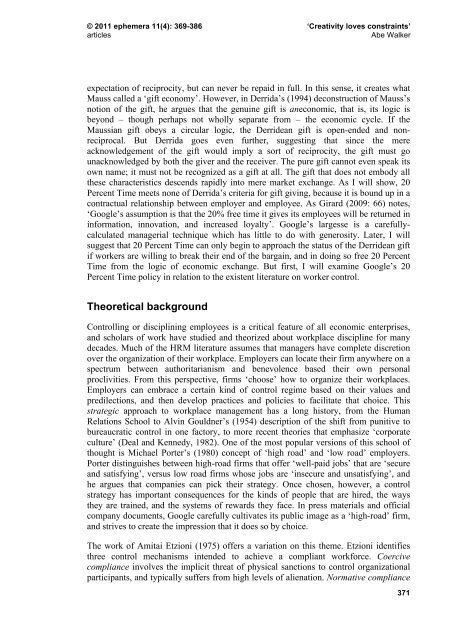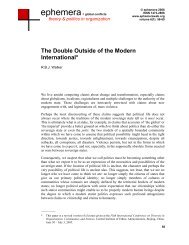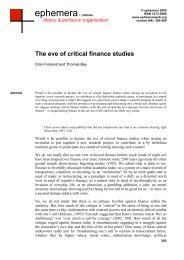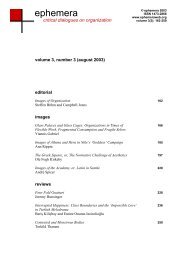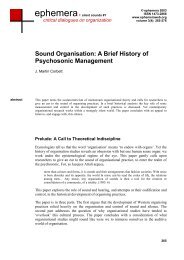Work, play and boredom - Ephemera
Work, play and boredom - Ephemera
Work, play and boredom - Ephemera
Create successful ePaper yourself
Turn your PDF publications into a flip-book with our unique Google optimized e-Paper software.
© 2011 ephemera 11(4): 369-386 ‘Creativity loves constraints’<br />
articles Abe Walker<br />
expectation of reciprocity, but can never be repaid in full. In this sense, it creates what<br />
Mauss called a ‘gift economy’. However, in Derrida’s (1994) deconstruction of Mauss’s<br />
notion of the gift, he argues that the genuine gift is aneconomic, that is, its logic is<br />
beyond – though perhaps not wholly separate from – the economic cycle. If the<br />
Maussian gift obeys a circular logic, the Derridean gift is open-ended <strong>and</strong> nonreciprocal.<br />
But Derrida goes even further, suggesting that since the mere<br />
acknowledgement of the gift would imply a sort of reciprocity, the gift must go<br />
unacknowledged by both the giver <strong>and</strong> the receiver. The pure gift cannot even speak its<br />
own name; it must not be recognized as a gift at all. The gift that does not embody all<br />
these characteristics descends rapidly into mere market exchange. As I will show, 20<br />
Percent Time meets none of Derrida’s criteria for gift giving, because it is bound up in a<br />
contractual relationship between employer <strong>and</strong> employee. As Girard (2009: 66) notes,<br />
‘Google’s assumption is that the 20% free time it gives its employees will be returned in<br />
information, innovation, <strong>and</strong> increased loyalty’. Google’s largesse is a carefullycalculated<br />
managerial technique which has little to do with generosity. Later, I will<br />
suggest that 20 Percent Time can only begin to approach the status of the Derridean gift<br />
if workers are willing to break their end of the bargain, <strong>and</strong> in doing so free 20 Percent<br />
Time from the logic of economic exchange. But first, I will examine Google’s 20<br />
Percent Time policy in relation to the existent literature on worker control.<br />
Theoretical background<br />
Controlling or disciplining employees is a critical feature of all economic enterprises,<br />
<strong>and</strong> scholars of work have studied <strong>and</strong> theorized about workplace discipline for many<br />
decades. Much of the HRM literature assumes that managers have complete discretion<br />
over the organization of their workplace. Employers can locate their firm anywhere on a<br />
spectrum between authoritarianism <strong>and</strong> benevolence based their own personal<br />
proclivities. From this perspective, firms ‘choose’ how to organize their workplaces.<br />
Employers can embrace a certain kind of control regime based on their values <strong>and</strong><br />
predilections, <strong>and</strong> then develop practices <strong>and</strong> policies to facilitate that choice. This<br />
strategic approach to workplace management has a long history, from the Human<br />
Relations School to Alvin Gouldner’s (1954) description of the shift from punitive to<br />
bureaucratic control in one factory, to more recent theories that emphasize ‘corporate<br />
culture’ (Deal <strong>and</strong> Kennedy, 1982). One of the most popular versions of this school of<br />
thought is Michael Porter’s (1980) concept of ‘high road’ <strong>and</strong> ‘low road’ employers.<br />
Porter distinguishes between high-road firms that offer ‘well-paid jobs’ that are ‘secure<br />
<strong>and</strong> satisfying’, versus low road firms whose jobs are ‘insecure <strong>and</strong> unsatisfying’, <strong>and</strong><br />
he argues that companies can pick their strategy. Once chosen, however, a control<br />
strategy has important consequences for the kinds of people that are hired, the ways<br />
they are trained, <strong>and</strong> the systems of rewards they face. In press materials <strong>and</strong> official<br />
company documents, Google carefully cultivates its public image as a ‘high-road’ firm,<br />
<strong>and</strong> strives to create the impression that it does so by choice.<br />
The work of Amitai Etzioni (1975) offers a variation on this theme. Etzioni identifies<br />
three control mechanisms intended to achieve a compliant workforce. Coercive<br />
compliance involves the implicit threat of physical sanctions to control organizational<br />
participants, <strong>and</strong> typically suffers from high levels of alienation. Normative compliance<br />
371


